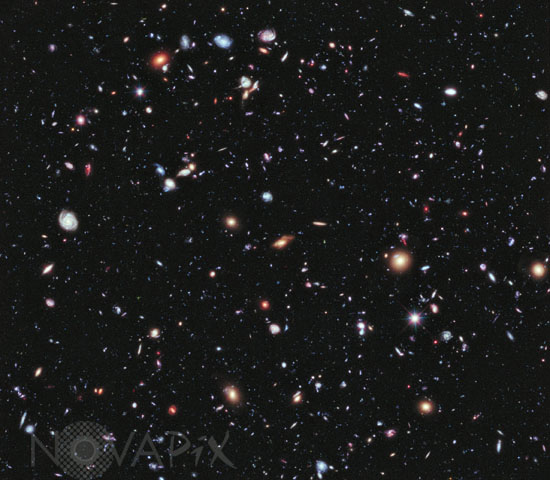Photo Agency - Astronomy - Space - Nature

Distant galaxies - Hubble eXtreme Deep Field (XDF)
author: Nasa/ESA/Novapix
reference: a-gax97-00038
Image Size 300 DPI: 20 * 17 cm
Called the eXtreme Deep Field, or XDF, the photo was assembled by combining 10 years of NASA Hubble Space Telescope photographs taken of a patch of sky at the center of the original Hubble Ultra Deep Field. The XDF is a small fraction of the angular diameter of the full Moon.
The Hubble Ultra Deep Field is an image of a small area of space in the constellation Fornax, created using Hubble Space Telescope data from 2003 and 2004. By collecting faint light over many hours of observation, it revealed thousands of galaxies, both nearby and very distant, making it the deepest image of the universe ever taken at that time.
The new full-color XDF image reaches much fainter galaxies, and includes very deep exposures in red light from Hubble's new infrared camera, enabling new studies of the earliest galaxies in the universe. The XDF contains about 5,500 galaxies even within its smaller field of view. The faintest galaxies are one ten-billionth the brightness of what the human eye can see. The universe is 13.7 billion years old, and the XDF reveals galaxies that span back 13.2 billion years in time. Most of the galaxies in the XDF are seen when they were young, small, and growing, often violently as they collided and merged together. The early universe was a time of dramatic birth for galaxies containing brilliant blue stars extraordinarily brighter than our Sun. The light from those past events is just arriving at Earth now, and so the XDF is a "time tunnel into the distant past." The youngest galaxy found in the XDF existed just 450 million years after the universe's birth in the big bang.
Contact : Stéphane Aubin +33-(0)9-51-26-53-76
© Novapix - All rights reserved


